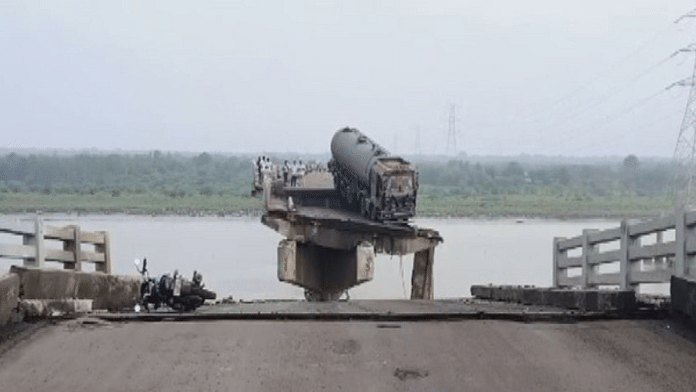Thank you dear subscribers, we are overwhelmed with your response.
Your Turn is a unique section from ThePrint featuring points of view from its subscribers. If you are a subscriber, have a point of view, please send it to us. If not, do subscribe here: https://theprint.in/subscribe/
From collapsing pedestrian bridges to crumbling highways, headlines increasingly remind us that the infrastructure holding our societies together is under stress. But the cracks we see aren’t just in concrete—they’re in the systems we use to build and maintain our infrastructure. At the heart of the issue lies a flawed procurement model known as L1 bidding.
The conventional L1 tendering system, wherein contracts are awarded solely based on the lowest bid, remains the default mechanism for large and critical infrastructure. While it aims to ensure fiscal discipline, this system fails to account for the long-term performance, safety, and sustainability of infrastructure—particularly in large-scale, critical projects such as dams, expressways, canals, and river bridges.
In the realm of infrastructure development, especially in large-scale projects like dams, expressways, canals, and river bridges, cost-efficiency is a critical factor. Traditionally, many governments and public sector bodies rely on the L1 tendering system—where the contract is awarded to the lowest bidder. While the intention is to ensure financial prudence, this approach often leads to unintended consequences in the long term, particularly regarding the durability and lifecycle cost of critical infrastructure.
One of the most significant technical risks facing such infrastructure is corrosion of embedded steel reinforcement, which severely compromises structural integrity and safety over time. The adoption of corrosion-resistant stainless steel, although higher in upfront cost, offers substantial life-cycle savings, risk mitigation, and environmental benefits.
Corrosion has emerged as a silent but significant threat to the longevity of infrastructure. In this context, adopting stainless steel components is no longer a luxury but a necessity.
Problem with the L1 System
The L1 (Lowest Bidder) model prioritizes the upfront cost without sufficiently evaluating the long-term performance, maintenance costs, and durability of materials and construction methods. Contractors, in a bid to win the project, often cut corners on quality, selecting substandard materials that may not withstand the test of time—especially in corrosive environments.
Infrastructure like dams and bridges are expected to last 50–100 years or more. However, the L1 model does not incentivize innovation, quality engineering, or material excellence, which are essential for ensuring that these assets perform well throughout their lifecycle.
Ironically, projects awarded under L1 often incur higher lifecycle costs. Frequent maintenance, repairs, and early replacements lead to significant expenditures over the life of the infrastructure—costs that far outweigh the initial “savings” from choosing the lowest bidder.
Poor-quality construction materials can lead to premature failures, posing serious safety risks. In case of a dam or a bridge, these failures can be catastrophic. Moreover, repeated repairs increase the environmental footprint, undermining sustainable development goals.
Threat of Corrosion in Infrastructure
Corrosion is one of the leading causes of degradation in infrastructure, particularly in environments with high moisture, salinity, or industrial pollution. Structures like canals, river bridges, and coastal expressways are especially vulnerable.
Most infrastructure uses carbon steel for reinforcing concrete. In the presence of water and oxygen, especially in saline or acidic environments, this steel corrodes—leading to cracking, spalling, and weakening of the structure. Detecting corrosion within concrete is difficult and often occurs only after visible damage. The cost and complexity of retrofitting corroded structures are substantial.
A Long-Term Solution
Enhancing structural integrity and safety in large infrastructure projects—such as dams, expressways, canals, tunnels, and bridges—requires a multi-disciplinary approach that integrates materials science, advanced engineering practices, digital tools, and policy-level reforms.
Stainless steel, particularly grades like 304, 316, and duplex stainless steels, offers exceptional resistance to corrosion, making it ideal for harsh environments. It is particularly effective in marine and coastal areas, as well as places with fluctuating weather conditions. By preventing corrosion-related damage, stainless steel ensures the longevity and structural integrity of critical infrastructure. This is vital for public safety, especially in high-load or water-intensive projects.
Though the initial cost of stainless steel is higher than conventional carbon steel, it offers significantly lower maintenance and repair costs over the life of the structure. This makes it a more economical choice in the long term, aligning with principles of value engineering. Stainless steel is 100% recyclable and has a lower environmental footprint due to its longevity and minimal maintenance requirements. Its adoption supports green infrastructure development goals.
The Way Forward: Reforming Procurement and Design Practices
The L1 procurement model, while rooted in fiscal prudence, is increasingly misaligned with the complexities and long-term demands of modern infrastructure. In critical sectors such as dams, expressways, bridges, and canals, the lowest-cost approach often leads to compromises in material quality, durability, and public safety—ultimately resulting in higher lifecycle costs and premature degradation.
To truly optimize infrastructure performance, the focus must shift from the L1 model to Quality and Cost-Based Selection (QCBS) or Value-Based Procurement frameworks. These approaches consider: Material durability, Lifecycle cost analysis, Environmental impact, Safety and resilience, etc.
Relying solely on the L1 approach for large-scale infrastructure is a short-sighted practice. It is time to move beyond cost as the sole criterion and embrace a procurement framework that reflects the true value of infrastructure—not just at inception, but over decades of public service.


